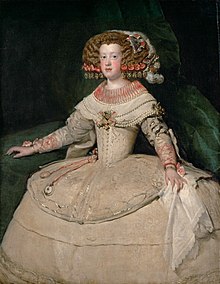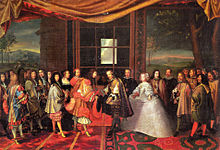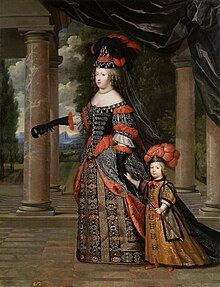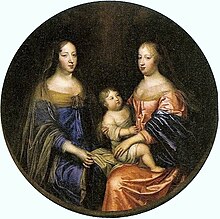| Maria Theresa of Spain | |||||
|---|---|---|---|---|---|
 Portrait by Henri and Charles Beaubrun Portrait by Henri and Charles Beaubrun | |||||
| Queen consort of France | |||||
| Tenure | 9 June 1660 – 30 July 1683 | ||||
| Born | (1638-09-10)10 September 1638 El Escorial, Crown of Castile | ||||
| Died | 30 July 1683(1683-07-30) (aged 44) Palace of Versailles, Kingdom of France | ||||
| Burial | Basilica of St Denis | ||||
| Spouse |
Louis XIV (m. 1660) | ||||
| Issue more... | Louis François, Duke of Anjou | ||||
| |||||
| House | Habsburg | ||||
| Father | Philip IV of Spain | ||||
| Mother | Elisabeth of France | ||||
| Signature | |||||
Maria Theresa of Spain (Spanish: María Teresa de Austria; French: Marie-Thérèse d'Autriche; 10 September 1638 – 30 July 1683) was Queen of France from 1660 to 1683 as the wife of King Louis XIV. She was born an Infanta of Spain and Portugal as the daughter of King Philip IV and Elisabeth of France, and was also an Archduchess of Austria as a member of the Spanish branch of the House of Habsburg.
Her marriage in 1660 to King Louis XIV, her double first cousin, was arranged with the purpose of ending the lengthy war between France and Spain. Famed for her virtue and piety, she saw five of her six children die in early childhood, and is frequently viewed as an object of pity in historical accounts of her husband's reign, since she was often neglected by the court and overshadowed by the King's many mistresses.
Without any political influence in the French court or government (except briefly in 1672, when she was named regent during her husband's absence during the Franco-Dutch War), she died aged 44 due to complications from an abscess on her arm. Her grandson Philip V inherited the Spanish throne in 1700 after the death of her younger half-brother, Charles II. The resulting War of the Spanish Succession established the House of Bourbon as the new ruling dynasty of Spain, where it has reigned with some interruption until the present time.
Biography
Birth and early life


Born at the Royal Monastery of El Escorial, the Infanta Maria Theresa was the daughter of Philip IV & III and his first wife Elisabeth of France. She was named after Sainte Thérèse, who Elisabeth chose to protect her daughter. As a member of the House of Austria, Maria Theresa was entitled to use the title Archduchess of Austria. She was known in Spain as María Teresa de Austria and in France as Marie-Thérèse d'Autriche.
Maria Theresa was raised by the royal governess Luisa Magdalena de Jesus. Her religious education was first carried out by Juan de Palma. Later, Father Vasquez, a man recognised in Spain for being highly educated and of great virtue, was entrusted with the spiritual education of the young Infanta. Elisabeth of France died when Maria Theresa was six years old. The Infanta was very close to her step-mother, Mariana of Austria, who was only five years her senior.
Unlike France, Spain had no Salic Law, so it was possible for a female to assume the throne. When Maria Theresa's brother Balthasar Charles died in 1646, she became heir presumptive to the vast Spanish Empire and remained such until the birth of her brother Philip Prospero, in 1657. She was briefly heir presumptive once more between 1 and 6 November 1661, following the death of Prince Philip and until the birth of Prince Charles, who would later inherit the thrones of Spain as Charles II.
Betrothal and proxy marriage
In 1658, as war with France began to wind down, a union between the royal families of Spain and France was proposed as a means to secure peace. Maria Theresa and the French king were double first cousins: Louis XIV's father was Louis XIII, who was the brother of Maria Theresa's mother, while her father was brother to Anne of Austria, Louis XIV's mother. Spanish procrastination led to a scheme in which France's chief minister, Cardinal Mazarin, pretended to seek a marriage for his master with Margaret Yolande of Savoy. When Philip IV of Spain heard of a meeting at Lyon between the Houses of France and Savoy in November 1658, he reputedly exclaimed of the Franco-Savoyard union that "it cannot be, and will not be". Philip then sent a special envoy to the French court to open negotiations for peace and a royal marriage.
The negotiations for the marriage contract were intense. Eager to prevent a union of the two countries or crowns, especially one in which Spain would be subservient to France, the diplomats sought to include a renunciation clause that would deprive Maria Theresa and her children of any rights to the Spanish succession. A marriage contract was eventually arranged in November 1659 as one of the provisions of the Treaty of the Pyrenees. The contract specified that Maria Theresa was to renounce all claims to Spanish territory for herself and all her descendants. Mazarin and Lionne, however, made the renunciation conditional on the full payment of a Spanish dowry of 500,000 écus. As it turned out, Spain, impoverished and bankrupt after decades of war, was unable to pay such a dowry, and France never received the agreed upon sum.
On 2 June 1660, Maria Theresa was married by proxy to Louis at Fuenterrabia. Luis Méndez de Haro acted as bridegroom.
Marriage

Philip IV and the entire Spanish court accompanied the bride to the Isle of Pheasants on the border in the Bidassoa river, where Louis and his court met her in the meeting on the Isle of Pheasants on 7 June 1660, and she entered France. On 9 June the marriage took place in Saint-Jean-de-Luz at the recently rebuilt church of Saint Jean the Baptist. After the wedding, Louis wanted to consummate the marriage as quickly as possible.


Queen of France

On 26 August 1660, the newlyweds made the traditional Joyous Entry into Paris. Louis was highly affectionate and attentive to the new Queen, commanding the Grand Maréchal du Logis that "the Queen and himself were never to be set apart, no matter how small the house in which they might be lodging". However, his devotion was short-lived and he promptly began pursuing Louise de La Vallière.
Maria Theresa became pregnant for the first time in early 1661. She gave birth to the long-awaited Dauphin on 1 November 1661, fulfilling her primary duty as Queen. Louis stayed by her side during the difficult birth and exhibited immense care and support but returned to his mistress, La Valliere, shortly after.
Maria Theresa had trouble adjusting to life at the French court, often struggling to understand French pleasures and humor. She clung to her aunt, the Queen Mother, Anne of Austria, whom she affectionately referred to as “tia”. Religiously devout, Maria Theresa enjoyed long masses and the celebration of traditional Spanish fêtes. Outside of praying, she spent much of her free time playing cards and gambling. Maria Theresa played little part in political affairs, although she briefly acted as regent in 1667 while her husband was away on campaigns on the frontier.
Louis initially attempted to keep his constant infidelity hidden, but became more overt as time progressed. Maria Theresa despised her husband's prolonged infidelity with Françoise-Athénaïs, Marquise de Montespan. Louis reprimanded Madame de Montespan when her behaviour at court too flagrantly disrespected the queen's position, yet often displayed a level of indulgence toward her that surpassed his treatment of the queen.
Later, the governess of Montespan's illegitimate children by the king, Madame de Maintenon, came to supplant her mistress in the king's affections. At first she resisted the king's advances and encouraged him to bestow more attention on his long-neglected wife, a thoughtfulness which Maria Theresa repaid with warmth toward the new favourite. After the queen's death, Maintenon would become the king's second, although officially secret, wife.
There were rumours that Maria Theresa had an illegitimate daughter, Louise Marie Thérèse (The Black Nun of Moret).
Death

In July 1683, Maria Theresa developed an abscess in her armpit that gave rise to a fever. Her physician, Guy-Crescent Fagon, insisted on bleeding her despite objections. She died a painful death on 30 July 1683. Upon her death, Louis XIV said: "This is the first chagrin she has ever given me." For the grand funeral ceremony, Marc-Antoine Charpentier composed dramatic motets H.409, H.189, H.331 and Jean-Baptiste Lully his Dies irae. The funeral prayer was by Bossuet.
Issue
Maria Theresa married her double first cousin Louis XIV in 1660. The couple had six children, only one of whom survived to adulthood:
- Louis, Grand Dauphin (1 November 1661 – 14 April 1711) married Maria Anna Victoria of Bavaria, had issue.
- Anne-Élisabeth (18 November 1662 – 30 December 1662); died in infancy.
- Marie-Anne (16 November 1664 – 26 December 1664); died in infancy.
- Marie Thérèse (2 January 1667 – 1 March 1672); styled as Madame Royale, died at the age of five.
- Philippe Charles (5 August 1668 – 10 July 1671); styled as Duke of Anjou, died at the age of two.
- Louis François (14 June 1672 – 4 November 1672); styled Duke of Anjou, died in infancy.
Of her six children, only one survived her, Louis, le Grand Dauphin, the oldest one, who died in 1711. One of her younger grandsons eventually inherited her claim to the Spanish throne to become King Philip V of Spain in 1700.
Ancestry
| This section does not cite any sources. Please help improve this section by adding citations to reliable sources. Unsourced material may be challenged and removed. (April 2019) (Learn how and when to remove this message) |
| Ancestors of Maria Theresa of Spain | |||||||||||||||||||||||||||||||||||||||||||||||||||||||||||||||||||||||||||||||||||||||||||||||||||||||||||||||||||||||||||||||||||||||||||||||||||||||||||||||||||||||||||||||||||||||||||||||||||||||||||||||||||||||||||||||||||||||||||||||||||||||||||||||||||||||||||||||||||||||||
|---|---|---|---|---|---|---|---|---|---|---|---|---|---|---|---|---|---|---|---|---|---|---|---|---|---|---|---|---|---|---|---|---|---|---|---|---|---|---|---|---|---|---|---|---|---|---|---|---|---|---|---|---|---|---|---|---|---|---|---|---|---|---|---|---|---|---|---|---|---|---|---|---|---|---|---|---|---|---|---|---|---|---|---|---|---|---|---|---|---|---|---|---|---|---|---|---|---|---|---|---|---|---|---|---|---|---|---|---|---|---|---|---|---|---|---|---|---|---|---|---|---|---|---|---|---|---|---|---|---|---|---|---|---|---|---|---|---|---|---|---|---|---|---|---|---|---|---|---|---|---|---|---|---|---|---|---|---|---|---|---|---|---|---|---|---|---|---|---|---|---|---|---|---|---|---|---|---|---|---|---|---|---|---|---|---|---|---|---|---|---|---|---|---|---|---|---|---|---|---|---|---|---|---|---|---|---|---|---|---|---|---|---|---|---|---|---|---|---|---|---|---|---|---|---|---|---|---|---|---|---|---|---|---|---|---|---|---|---|---|---|---|---|---|---|---|---|---|---|---|---|---|---|---|---|---|---|---|---|---|---|---|---|---|---|---|---|---|---|---|---|---|---|---|---|---|---|---|---|---|---|---|
| |||||||||||||||||||||||||||||||||||||||||||||||||||||||||||||||||||||||||||||||||||||||||||||||||||||||||||||||||||||||||||||||||||||||||||||||||||||||||||||||||||||||||||||||||||||||||||||||||||||||||||||||||||||||||||||||||||||||||||||||||||||||||||||||||||||||||||||||||||||||||
References
- Whitfield, J. H. (June 1969). "La Belle Charite II: Racine, Molière and the Pastor Fido". Italian Studies. 24 (1): 76–92. doi:10.1179/its.1969.24.1.76. ISSN 0075-1634.
- Khan, Samra Sarfraz; Hussain, Irum Iqbal (2019). "Matrimony and Monarchy: The Failure of Bourbon-Habsburg Matrimonial Alliance". Journal of History and Social Sciences. 10 (2). doi:10.22555/jhss.v10i2.93. ISSN 2221-6804. S2CID 216542130.
- Fichtner, Paula Sutter (2003), Fichtner, Paula Sutter (ed.), "Creating a State", The Habsburg Monarchy, 1490–1848: Attributes of Empire, European History in Perspective, London: Macmillan Education UK, pp. 59–88, doi:10.1007/978-1-137-10642-1_3, ISBN 978-1-137-10642-1, retrieved 2023-09-18
- Nevile, Jennifer (2008-06-25). Dance, Spectacle, and the Body Politick, 1250–1750. Indiana University Press. ISBN 978-0-253-21985-5.
- ^ "Marie-Therese D'autriche". Chateau de Versailles. Retrieved 25 November 2023.
- Anselme 1726, p. 174.
- Duclos 1869, p. 6
- "Luisa Enríquez Manrique de Lara | Real Academia de la Historia".
- "Juan de Palma | Real Academia de la Historia". dbe.rah.es. Retrieved 2022-04-04.
- Duclos 1869, p. 17
- Hume 1907, pp. 392–393.
- Mitchell 2013, p. 381.
- Hume 1907, p. 415.
- Mitchell 2013, pp. 48–50.
- Dunlop 2000, p. 352.
- Orso 1989, pp. 77–78.
- Orso 1989, p. 79.
- Brown, Jonathan (1980). A Palace for a King: The Buen Retiro and the Court of Philip IV. New Haven and London: Yale University Press. p. 197.
- Wolf 1968, p. 99.
- Dunlop 2000, p. 48.
- Lynch, John (1969). Spain Under the Habsburgs. New York: Oxford University Press. p. 123. ISBN 978-0-631-08030-5. Retrieved 27 November 2023.
- ^ Wolf 1968, p. 117.
- Dunlop 2000, p. 54.
- Wolf 1968, p. 121.
- Dunlop 2000, p. 55.
- Dunlop 2000, p. 57.
- Wolf 1968, p. 123.
- Wolf 1968, p. 124.
- Dunlop 2000, p. 58.
- Anselme 1726, p. 157.
- Dunlop 2000, p. 63.
- Dunlop 2000, p. 59.
- Dunlop 2000, pp. 79–80.
- Dunlop 2000, p. 69.
- Cortequisse 1992, p. 67.
- Dunlop 2000, p. 80.
- Prince of Greece 1983, p. 113.
- Wolf 1968, p. 286.
- Wolf 1968, p. 287.
- Wolf 1968, p. 288.
- Wolf 1968, p. 289.
- Prince of Greece 1983, p. 101.
- Dunlop 2000, pp. 153–154.
- Prince of Greece 1983, p. 121.
- Prince of Greece 1983, p. 136.
- Prince of Greece 1983, pp. 166–167.
- Prince of Greece 1983, p. 193.
- Prince of Greece 1983, p. 186.
- Prince of Greece 1983, p. 230.
- ^ Prince of Greece 1983, p. 231.
- Dunlop 2000, pp. 261–262.
- Prince of Greece 1983, p. 126.
- Cortequisse 1992, p. 82.
- Dunlop 2000, p. 261.
- Wolf 1968, p. 328.
- ^ Anselme 1726, p. 175.
- Wolf 1968, p. 314.
- Prince of Greece 1983, p. 308-309.
Sources
- Anselme de Sainte-Marie, Père (1726). Histoire généalogique et chronologique de la maison royale de France [Genealogical and chronological history of the royal house of France] (in French). Vol. 1 (3rd ed.). Paris: La compagnie des libraires.
- Chisholm, Hugh, ed. (1911). "Marie Thérèse" . Encyclopædia Britannica. Vol. 20 (11th ed.). Cambridge University Press. p. 715.
- Cortequisse, Bruno (1992). Madame Louis XIV (in French). Paris: Perrin.
- Duclos, Henri-Louis (1869). Madame de La Vallière et Marie-Thérèse d'Autriche, femme de Louis XIV : avec pièces et documents inédits (in French). Paris.
{{cite book}}: CS1 maint: location missing publisher (link) - Dunlop, Ian (2000). Louis XIV. London: Pimlico. ISBN 9780712667098.
- Hume, Martin (1907). Court of Philip IV: Spain in Decline. New York: G. P. Putnam's Sons.
- Mitchell, Silvia Z. (2013). Mariana of Austria and Imperial Spain: Court, Dynastic, and International Politics in Seventeenth-Century Europe (Doctor of Philosophy (PhD) thesis). Retrieved 21 November 2023.
- Orso, Steven (1989). Art and death at the Spanish Habsburg Court: The Royal Exequies for Philip IV. Columbia: University of Missouri Press. ISBN 978-0-8262-0710-4.
- Prince of Greece, Michael (1983). Louis XIV: The Other Side of the Sun. Translated by Alan Sheridan. New York: Harper & Row. ISBN 978-0-06-015217-8.
- Wolf, John B. (1968). Louis XIV. New York: W.W. Norton & Company, Inc.
External links
 Media related to Marie Thérèse of Austria at Wikimedia Commons
Media related to Marie Thérèse of Austria at Wikimedia Commons- Full text of marriage contract, France National Archives transcription (in French)
| Maria Theresa of Spain House of HabsburgBorn: 10 September 1638 Died: 30 July 1683 | ||
| French royalty | ||
|---|---|---|
| VacantTitle last held byAnne of Austria | Queen consort of France 1660 – 1683 |
VacantTitle next held byMaria Leszczyńska |
| Infantas of Spain | |
|---|---|
| Generations indicate descent from Carlos I, under whom the crowns of Castile and Aragon were united, forming the Kingdom of Spain. | |
| 1st generation | |
| 2nd generation | |
| 3rd generation | |
| 4th generation | |
| 5th generation |
|
| 6th generation |
|
| 7th generation | |
| 8th generation | |
| 9th generation | |
| 10th generation |
|
| 11th generation | |
| 12th generation | |
| 13th generation | |
| 14th generation | |
| 15th generation | |
| 16th generation | |
| *title granted by Royal Decree | |
| Infantas of Portugal | |||||||||||||||||||||||||||||||||||||||||||||||
|---|---|---|---|---|---|---|---|---|---|---|---|---|---|---|---|---|---|---|---|---|---|---|---|---|---|---|---|---|---|---|---|---|---|---|---|---|---|---|---|---|---|---|---|---|---|---|---|
| The generations indicate descent form Afonso I, and continues through the House of Aviz, the House of Habsburg through Infanta Isabel, Holy Roman Empress and Queen of Spain, and the House of Braganza through Infanta Catarina, Duchess of Braganza. | |||||||||||||||||||||||||||||||||||||||||||||||
| |||||||||||||||||||||||||||||||||||||||||||||||
| * also an infanta of Spain and an archduchess of Austria, ** also an imperial princess of Brazil, *** also a princess of Saxe-Coburg and Gotha, Duchess in Saxony, ◙ Also a princess of Braganza, ƒ title of pretense | |||||||||||||||||||||||||||||||||||||||||||||||
- 1638 births
- 1683 deaths
- 17th-century regents
- 17th-century House of Habsburg
- 17th-century women regents
- 17th-century French nobility
- 17th-century French women
- 17th-century Roman Catholics
- 17th-century Spanish nobility
- 17th-century Spanish women
- Queens consort of France
- Navarrese royal consorts
- Court of Louis XIV
- Regents of France
- House of Bourbon (Spain)
- Children of Philip IV of Spain
- Portuguese infantas
- Portuguese Roman Catholics
- Spanish Roman Catholics
- Spanish infantas
- Burials at the Basilica of Saint-Denis
- Spanish people of Austrian descent
- Castilian infantas
- Aragonese infantas
- Daughters of kings
- Daughters of dukes
- Daughters of counts